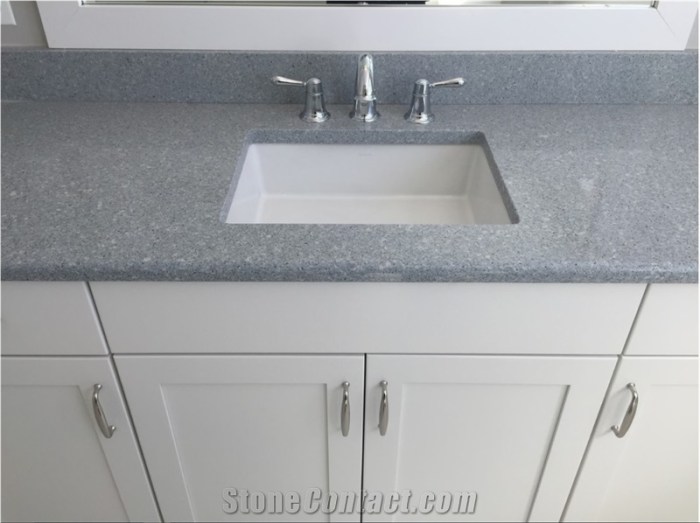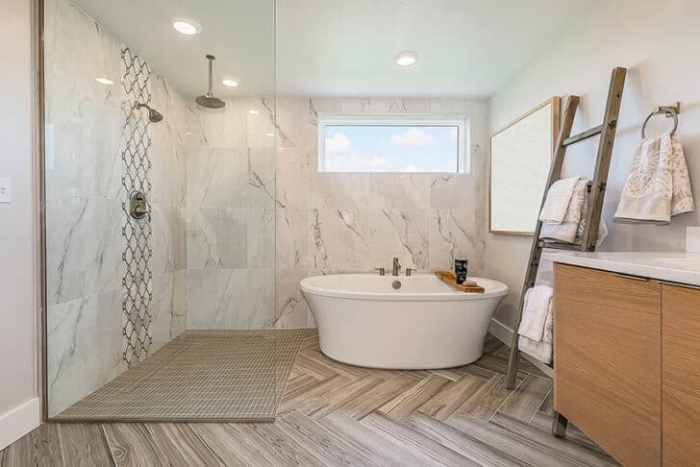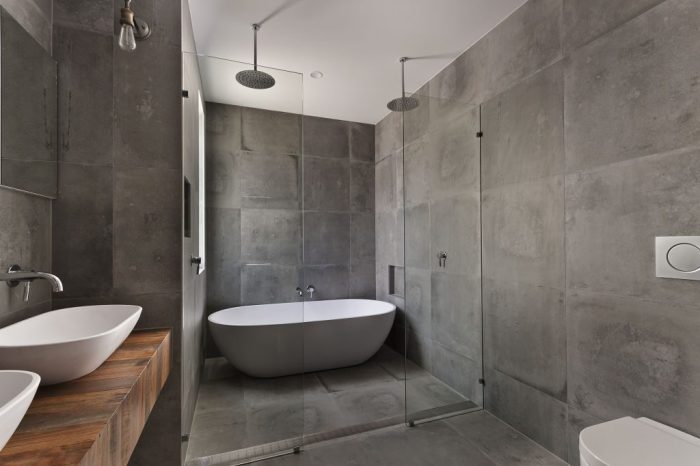Stepping into a bathroom should be a refreshing and rejuvenating experience, but moisture and humidity can quickly turn it into a breeding ground for mold and mildew. Non-porous quartz tiles offer the perfect solution for wet bathroom areas, providing a durable and stylish surface that will keep your bathroom looking pristine for years to come.
These tiles are crafted from a unique blend of quartz and resin, resulting in a material that is exceptionally resistant to water absorption, stains, and wear. Their non-porous nature makes them impervious to moisture, preventing the growth of mold and mildew, ensuring a healthier and more hygienic bathroom environment.
Non-Porous Quartz Tiles
Non-porous quartz tiles are a type of engineered stone tile made from a combination of natural quartz and resin binders. They offer a unique blend of durability, aesthetics, and ease of maintenance, making them a popular choice for wet bathroom areas.
Composition and Properties
Non-porous quartz tiles are composed of approximately 90-95% natural quartz, which is one of the hardest minerals on Earth. The remaining 5-10% consists of resin binders, which help to hold the quartz particles together and provide flexibility. This unique composition gives non-porous quartz tiles exceptional strength, durability, and resistance to water absorption, stains, and wear.
Benefits of Using Non-Porous Quartz Tiles in Wet Bathroom Areas
Non-porous quartz tiles are an excellent choice for wet bathroom areas due to their exceptional resistance to moisture and their ability to inhibit the growth of mold and mildew. These tiles offer numerous advantages that make them an ideal choice for bathrooms, ensuring a clean, healthy, and visually appealing space.
One of the primary benefits of using non-porous quartz tiles in wet bathroom areas is their ability to prevent the growth of mold and mildew. Mold and mildew thrive in moist environments, and their presence can not only be unsightly but also pose health risks.
Non-porous quartz tiles, however, do not absorb water or moisture, creating an unfavorable environment for mold and mildew to grow.
Ease of Cleaning and Maintenance
Non-porous quartz tiles are also incredibly easy to clean and maintain. Their non-porous surface prevents dirt and grime from penetrating the tiles, making them easy to wipe clean with a damp cloth or mild detergent. This ease of maintenance ensures that your bathroom remains hygienic and visually appealing with minimal effort.
Installation Considerations for Non-Porous Quartz Tiles in Wet Bathrooms
Installing non-porous quartz tiles in wet bathroom areas requires careful attention to surface preparation, adhesive selection, and grouting techniques. By following these guidelines, you can ensure a durable and waterproof installation.
Before starting the installation, ensure the bathroom surface is level, clean, and free of any debris or moisture. Choose an adhesive specifically designed for wet areas and apply it evenly to the back of the tiles. Use a notched trowel to create a consistent layer of adhesive and press the tiles firmly into place.
Grouting
Grouting is crucial for sealing the joints between the tiles and preventing water penetration. Use a grout that is resistant to moisture and mildew. Apply the grout with a grout float, filling the joints completely. Remove excess grout with a damp sponge and allow it to cure according to the manufacturer’s instructions.
| Step | Description |
|---|---|
| 1 | Prepare the bathroom surface by leveling, cleaning, and removing debris. |
| 2 | Apply adhesive to the back of the tiles using a notched trowel. |
| 3 | Press the tiles firmly into place, ensuring they are level and aligned. |
| 4 | Apply grout to the joints using a grout float, filling them completely. |
| 5 | Remove excess grout with a damp sponge and allow it to cure. |
Aesthetic Appeal of Non-Porous Quartz Tiles
Non-porous quartz tiles offer a vast spectrum of aesthetic possibilities, making them a versatile choice for wet bathroom areas. From vibrant hues to subtle neutrals, and intricate patterns to sleek finishes, there’s a tile to complement any bathroom design style.
Their ability to mimic natural materials like marble, granite, and wood adds a touch of elegance and sophistication to the space. The tiles are also highly customizable, allowing for personalized designs and patterns that reflect the homeowner’s unique style.
Color and Pattern Options
- Non-porous quartz tiles come in a wide range of colors, from bold and vibrant to soft and muted tones. This diversity enables homeowners to create a bathroom that matches their desired ambiance, whether it’s a serene spa-like retreat or a modern and vibrant sanctuary.
- Patterned quartz tiles add a touch of visual interest and character to the bathroom. From subtle veining to intricate geometric designs, these tiles can elevate the space and make it stand out from the ordinary.
Gallery of Aesthetic Options
- [Insert image of a bathroom with non-porous quartz tiles in a vibrant blue hue, creating a bold and inviting atmosphere.]
- [Insert image of a bathroom with non-porous quartz tiles mimicking marble, adding a touch of elegance and sophistication to the space.]
- [Insert image of a bathroom with non-porous quartz tiles featuring a unique geometric pattern, adding visual interest and character to the room.]
Maintenance and Care of Non-Porous Quartz Tiles
Non-porous quartz tiles are relatively easy to maintain and care for, making them an ideal choice for wet bathroom areas. Here’s a comprehensive guide to help you keep your quartz tiles looking their best:
- Regular Cleaning: Sweep or vacuum your bathroom floor regularly to remove loose dirt and debris. For a deeper clean, use a pH-neutral cleaner specifically designed for quartz surfaces. Avoid using harsh chemicals or abrasive cleaners, as these can damage the tiles.
- Frequency of Cleaning: The frequency of cleaning will depend on the amount of use your bathroom gets. For light use, weekly cleaning may be sufficient. For heavy use, you may need to clean your tiles more often.
- Preventing Damage: To prevent damage to your quartz tiles, avoid using sharp objects or heavy items on them. Also, avoid dragging heavy furniture across the tiles, as this can scratch the surface.
Comparison with Other Tile Materials for Wet Bathrooms
Non-porous quartz tiles offer several advantages over other commonly used tile materials for wet bathroom areas. Let’s compare quartz tiles to ceramic, porcelain, and natural stone based on their strengths, weaknesses, and cost considerations.
Ceramic Tiles
Ceramic tiles are a popular choice for bathrooms due to their affordability and wide range of colors and designs. However, they are not as durable as porcelain or quartz tiles and are more prone to chipping and cracking. Ceramic tiles also have a higher porosity, which makes them more susceptible to water damage and staining.
Porcelain Tiles
Porcelain tiles are more durable than ceramic tiles and have a lower porosity, making them a better choice for wet bathroom areas. They are also more resistant to chipping and cracking. However, porcelain tiles can be more expensive than ceramic tiles and may require professional installation.
Natural Stone Tiles
Natural stone tiles, such as marble and granite, offer a unique and luxurious look for bathrooms. However, they are also the most expensive option and require regular maintenance to prevent staining and etching. Natural stone tiles also have a higher porosity than quartz tiles, making them more susceptible to water damage.
Cost Considerations
The cost of tile materials varies depending on the type of tile, the size of the bathroom, and the complexity of the installation. In general, ceramic tiles are the most affordable option, followed by porcelain tiles and natural stone tiles.
Quartz tiles are typically more expensive than ceramic or porcelain tiles, but they offer superior durability and performance.
| Tile Material | Durability | Porosity | Cost |
|---|---|---|---|
| Ceramic | Low | High | Low |
| Porcelain | Medium | Low | Medium |
| Natural Stone | High | High | High |
| Quartz | High | Low | Medium to High |
Last Recap
Non-porous quartz tiles are not only functional but also aesthetically pleasing, available in a wide range of colors, patterns, and finishes to complement any bathroom design style. They are easy to clean and maintain, requiring minimal effort to keep them looking their best.
Whether you’re renovating an existing bathroom or building a new one, non-porous quartz tiles are the perfect choice for creating a beautiful, durable, and healthy bathroom space.



